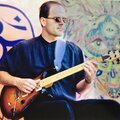-
Posts
1,534 -
Joined
-
Last visited
-
Days Won
321
Content Type
Profiles
Forums
Events
Shop
Everything posted by ezbass
-
Iconic combo.
-
-

Famous Guitarists and their Synonymous Guitars
ezbass replied to Crusoe's topic in General Discussion
I’d love an L5, or an ES175 at a pinch, but I’m quite attached to my kidneys. -

What Guitar-related Christmas Presents Did You Get?
ezbass replied to Crusoe's topic in General Discussion
Sweet FA. -
Hmm, influential to me? I'm not sure anyone consciously influenced my rhythm style, it just evolved, unlike my lead playing which was definitely player influenced. However, players whose rhythm playing I think is amazing are: Pete Townshend; Cory Wong; Nile Rodgers; Eddie Van Halen; Andy Summers; The Edge
-
I did a complete revalve on a Fender Hot Rod once. There was a small difference (slightly warmer/less harsh), but it was changing out the Eminence speaker for a Jensen that really made a big difference for that amp.
- 1 reply
-
- 1
-

-
Me neither, but something about gold top guitars just works for me.
-

Famous Guitarists and their Synonymous Guitars
ezbass replied to Crusoe's topic in General Discussion
I always think of him with a V, but that's down to the media at the time. However, Mick Ronson and a stripped LP . -
That mando SG is as cool as! I love the arch top too, but for different reasons.
-
One of our members has just been down this route, they might be able to help. Paging @Adders60.
-
A ‘silver face’ Twin probably.
-
Decided against the combo then?
-
Sorry to hear it didn’t work out, but it seems a way forward is already in hand.
-
Classic design, with a signature overdrive sound. That said, a clean Marshall is a wondrous thing. Enjoy.
-
I would imagine it is so that the chord isn’t muddied by the bass notes and changing the ‘flavour’ of the chord. For the open chords, a lot of folk just saw away on all 6 strings and it sounds fine, as you have pointed out it should. That said, there’s a lot to be said for training some restraint in the early days, as this will pay dividends further down the line, when it will be require. Have fun in your journey.
-
I’d forgotten how rewarding it can be to fit the right strings (for me at least) to an acoustic guitar. New strings on an electric are fine, but fitting a new set on an acoustic just makes it sing or, at least, can do. I bought my Inspired By Gibson, Hummingbird a fair while back. The strings it came with (12s) were fine, but a bit heavy for me. When I bought it, I picked up a set of D’Addario 10s and fitted them straight away. Nice guitar that it is, it didn’t have that Goldilocks thing of being just right with those strings. I refitted the original 12s and it was better, but still heavy for me and I’ve stuck with them for a fair while. Whilst buying something completely unrelated on Amazon, the other day, I remembered that the strings on my other, steel strung acoustic are really nice and that I bought them from Mr Bezos’ online empire. I checked my order history, to check what they were again, and I bought another set of them for the Hummingbird, DR Rare 11s. Just finished fitting them (complete with the inevitable puncture wound in a fingertip ) and what a difference! Yes, it sings because of the newness of the strings, but there’s something else, full bottom end (ooh, er, Mrs!), singing highs, supportive mids, properly loud and the tension is just right, I have achieved that Goldilocks balance of tone and playability. Therefore, if you have an acoustic that’s not delivering what you want, just try changing the strings for something you know works on other guitars, or take a punt on a previously untried brand/type of string, it might just be the thing you’ve been looking for and is cheaper than buying a new guitar (not that buying new guitars is bad, but needs must and all that).




